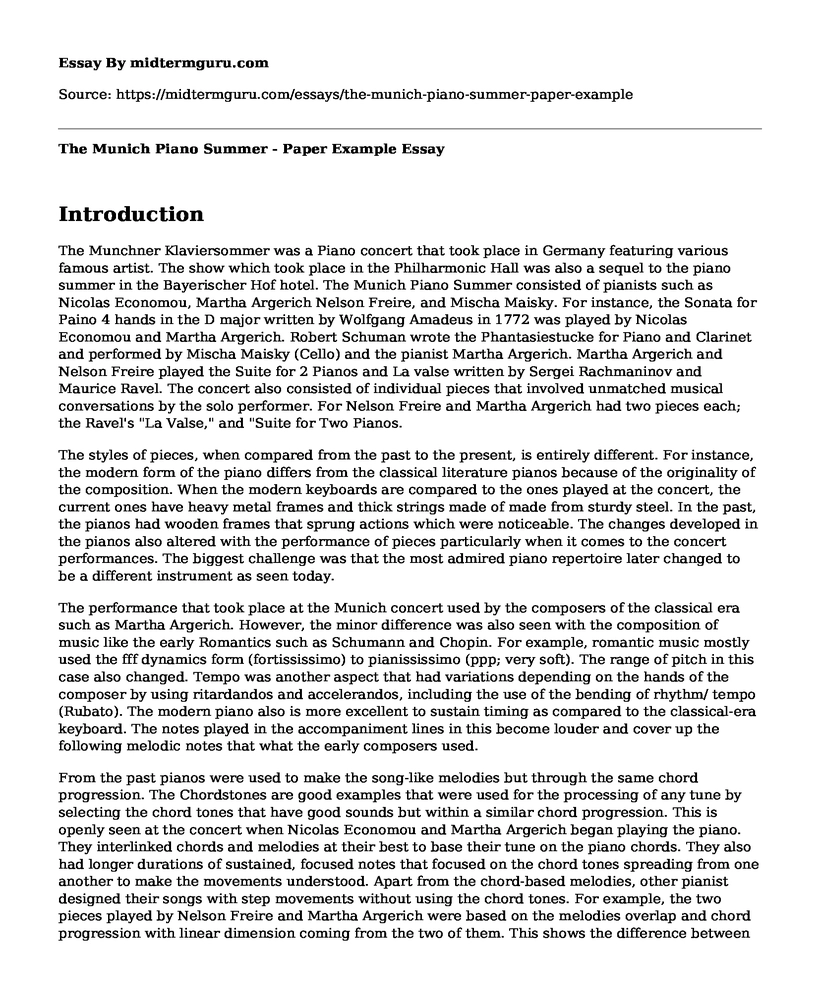Introduction
The Munchner Klaviersommer was a Piano concert that took place in Germany featuring various famous artist. The show which took place in the Philharmonic Hall was also a sequel to the piano summer in the Bayerischer Hof hotel. The Munich Piano Summer consisted of pianists such as Nicolas Economou, Martha Argerich Nelson Freire, and Mischa Maisky. For instance, the Sonata for Paino 4 hands in the D major written by Wolfgang Amadeus in 1772 was played by Nicolas Economou and Martha Argerich. Robert Schuman wrote the Phantasiestucke for Piano and Clarinet and performed by Mischa Maisky (Cello) and the pianist Martha Argerich. Martha Argerich and Nelson Freire played the Suite for 2 Pianos and La valse written by Sergei Rachmaninov and Maurice Ravel. The concert also consisted of individual pieces that involved unmatched musical conversations by the solo performer. For Nelson Freire and Martha Argerich had two pieces each; the Ravel's "La Valse," and "Suite for Two Pianos.
The styles of pieces, when compared from the past to the present, is entirely different. For instance, the modern form of the piano differs from the classical literature pianos because of the originality of the composition. When the modern keyboards are compared to the ones played at the concert, the current ones have heavy metal frames and thick strings made of made from sturdy steel. In the past, the pianos had wooden frames that sprung actions which were noticeable. The changes developed in the pianos also altered with the performance of pieces particularly when it comes to the concert performances. The biggest challenge was that the most admired piano repertoire later changed to be a different instrument as seen today.
The performance that took place at the Munich concert used by the composers of the classical era such as Martha Argerich. However, the minor difference was also seen with the composition of music like the early Romantics such as Schumann and Chopin. For example, romantic music mostly used the fff dynamics form (fortississimo) to pianississimo (ppp; very soft). The range of pitch in this case also changed. Tempo was another aspect that had variations depending on the hands of the composer by using ritardandos and accelerandos, including the use of the bending of rhythm/ tempo (Rubato). The modern piano also is more excellent to sustain timing as compared to the classical-era keyboard. The notes played in the accompaniment lines in this become louder and cover up the following melodic notes that what the early composers used.
From the past pianos were used to make the song-like melodies but through the same chord progression. The Chordstones are good examples that were used for the processing of any tune by selecting the chord tones that have good sounds but within a similar chord progression. This is openly seen at the concert when Nicolas Economou and Martha Argerich began playing the piano. They interlinked chords and melodies at their best to base their tune on the piano chords. They also had longer durations of sustained, focused notes that focused on the chord tones spreading from one another to make the movements understood. Apart from the chord-based melodies, other pianist designed their songs with step movements without using the chord tones. For example, the two pieces played by Nelson Freire and Martha Argerich were based on the melodies overlap and chord progression with linear dimension coming from the two of them. This shows the difference between two pianists that use the chord progression and single composers that use the sound pitches in the creation of melodies.
In the concert, several things like the physical approach of the composer had to the piano were observed. For instance, all pianist had proper postures by setting up their arms in a straight and relaxed position. They also had a sit up straight attitude but in a relaxed manner at the front of the bench. During a concert, it is vital that the performers avoid the use of the hand motions because of the speed to prevent the melodies becoming irrelevant or exaggerated. For instance, two performers such as Nicolas Economou and Martha Argerich always came in pairs (there were left and right flick with similar wrist motions). They also had natural movements by using their fingers and hands.
Conclusion
The recital part that impressed me was the Nicolas Economou and Martha Argerich performance in the Piano Sonata for four hands. Economou, in this case, deserves greater remembrance because of expressive he became when it came to the gossamer whispers dynamics because it roared into powerful fortissimos then receded it again to avoid losing the sense of the song. Typically, when playing music, flowing energy is needed while using such power, it can lead to wrong notes due to rushing fingers which happen several times. This can make music to lose its virtuosity. Economou's performance, however, made him more than a sideman particularly the final notes of Papillons he used. His tangled locks also pearled with sweat as his eyes searched in the sky waiting for the next letter to play. All the recital parts were exciting; none that did not catch my attention.
Work Cited
YouTube, 26 Jan. 2009, youtu.be/gUI5Iz3-7Bw.
Cite this page
The Munich Piano Summer - Paper Example. (2022, Aug 31). Retrieved from https://midtermguru.com/essays/the-munich-piano-summer-paper-example
If you are the original author of this essay and no longer wish to have it published on the midtermguru.com website, please click below to request its removal:
- Ludwig Van Beethoveni Biographical Information
- Essay on American Television Show: I Love Lucy
- Films Analysis Essay on Tapped and Affluenza
- Essay Sample on Role of Social Media in Freedom of Expression
- Film Analysis Essay on Carrie
- Film Analysis Essay on Satoshi Ito's "Genocidal Organ"
- Introduction to Public Opinion and Propaganda - Research Paper







